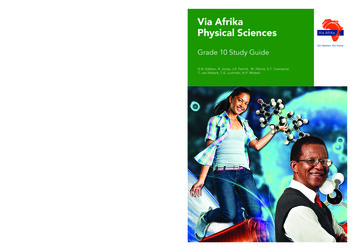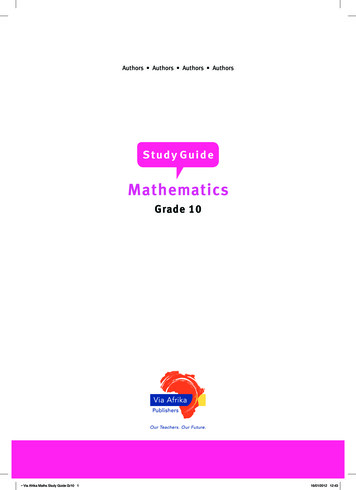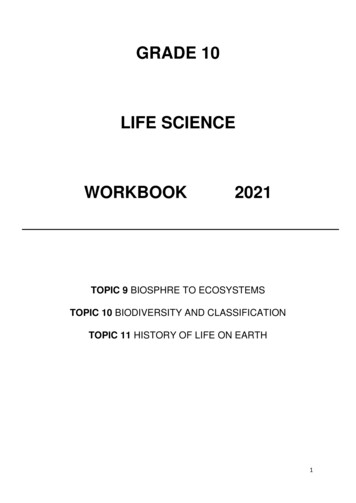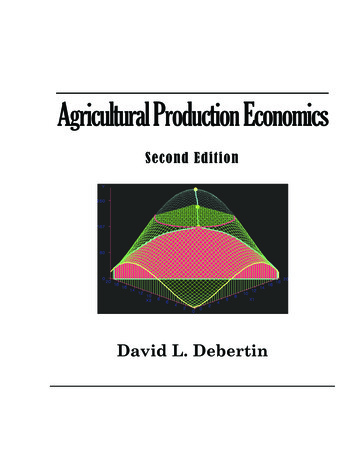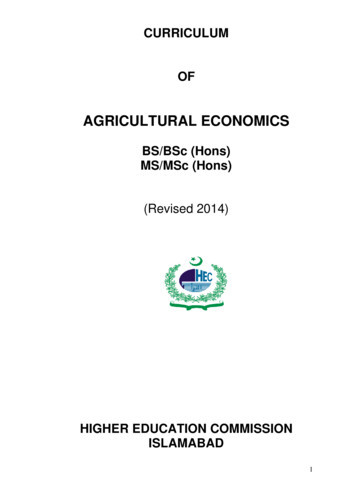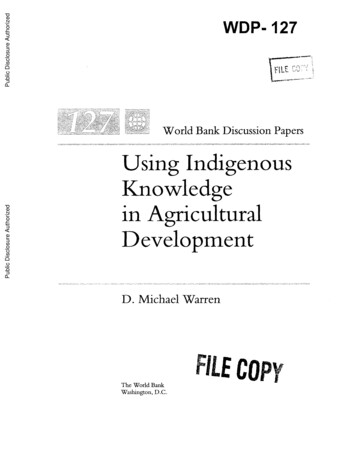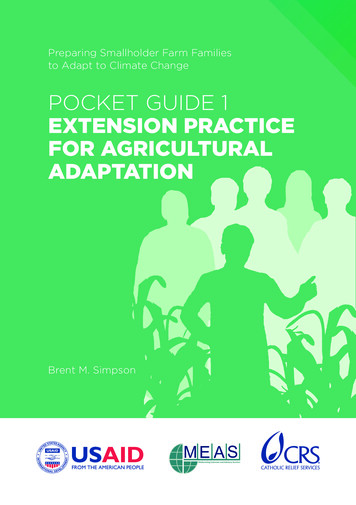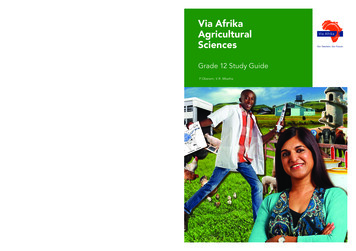
Transcription
need to look at what you can offer and what worksfor you, as well as taking into consideration thedifferent methodologies and teachings.Grade 12 Teacher’s GuideEducation is not static. It’s evolving, and I think youVia AfrikaAgriculturalSciencesGrade 12 t— Hemlata Govender, TeacherP.Oberem, V.R. Mbatha1. The series was written to be aligned with CAPS. See pages 8 to 11 to see how CAPS requirements are met.2. A possible work schedule has been included. See pages 4 and 5 to see how much time this could save you.3. Each unit starts with an overview of what is taught, and the resources you need. See page 19 to find out how this willhelp with your planning.4. There is advice on pace-setting to assist you in completing all the work for the year on time. Page 17 shows you how thisis done.5. Advice on how to introduce concepts and scaffold learning is given for every topic. See pages 19 and 20 for an example.6. All the answers have been given to save you time doing the exercises yourself. See page 21 for an example.7. Also included is a CD filled with resources to assist you in your teaching and assessment. See the inside front cover.The accompanying Learner’s Book is written in accessible language and contains all the content your learners need to master.The exciting design and layout will keep their interest and make teaching a pleasure for you.We would love to hear your feedback. Why not tell us how it’s going by emailing us at agriculturalsciences@viaafrika.com?Alternatively, visit our teacher forum at www.viaafrika.com.Language: Englishwww.viaafrika.comVia Afrika Agricultural SciencesVia Afrika understands, values and supports your role as a teacher. You have the most important job in education, and werealise that your responsibilities involve far more than just teaching. We have done our utmost to save you time and makeyour life easier, and we are very proud to be able to help you teach this subject successfully. Here are just some of the thingswe have done to assist you in this brand-new course:Guide
Study GuideVia AfrikaAgricultural SciencesGrade 12ISBN: 978-1-41546-296-6
ContentsIntroduction to Agricultural Sciences .1Topic 1 Animal nutrition and digestion .2Unit 1 Animal nutrition . 3Unit 2 Digestion in non-ruminants and ruminants . 6Unit 3 All about feed and feed flow planning .12Topic questions . 32Topic 2 Animal production . 35Unit 1 Animal production systems . 36Unit 2 Animal shelter . 39Unit 3 Behaviour and handling of farm animals .45Topic questions .53Topic 3 Animal reproduction . 55Unit 1 The male reproductive system . 56Unit 2 The female reproductive system .61Unit 3 Natural mating and other forms of reproduction . 67Unit 4 Fertilisation and pregnancy. 71Unit 5 The birth process (parturition) .74Unit 6 Lactation .77Topic questions . 80Topic 4 Animal health and diseases .83Unit 1 Animal health . 84Unit 2 Animal diseases . 88Unit 3 Parasites in farm animals. 98Unit 4 Plant and metallic salt poisoning . 105Topic questions .108
Topic 5 Basic agricultural genetics . 111Unit 1 Basic genetic concepts. 112Unit 2 Patterns of inheritance . 117Unit 3 Variation and mutation . 119Unit 4 Selection and breeding .122Unit 5 Genetic modification .126Topic questions . 131Topic 6 Agric-economic production factors . 135Unit 1 Land as an agric-production factor .136Unit 2 Labour as an agric-production factor . 139Unit 3 Capital as an agric-production factor . 143Unit 4 Management as an agric-production factor .149Topic questions . 156Topic 7 Agricultural marketing . 159Unit 1 What is agricultural marketing? .160Unit 2 Agricultural marketing systems .168Topic questions . 176Topic 8 Agricultural entrepreneurship and business planning . 179Unit 1 Agricultural entrepreneurship.180Unit 2 Agri-business plan .182Topic questions . 187Answers to Topic questions . 191
Introduction to Agricultural SciencesAgricultural Sciences is the study of the relationship between soils, plants and animalsin the production and processing of food, fibre, fuel and other agricultural commoditiesthat have an economic, aesthetic and cultural value. Agricultural Sciences is an integratedscience. It combines knowledge and skills from Physical Sciences, Life Sciences, SocialSciences, Earth Sciences, Engineering, Mathematics and Economics. This subject must beseen within the holistic science framework rather than as an isolated science.In Agricultural Sciences you will: develop an awareness of the management and care of the environment, naturalresources and the humane treatment of animals through application of scienceand related technology develop problem-solving mechanisms within the contexts of agriculturalproduction, processing and marketing practices be aware of the social and economic development of the society at large throughpersonal development in commercial and subsistence farming enterprises become informed and responsible citizens in the production of agriculturalcommodities, caring for the environment and addressing social justice issues be aware of agricultural indigenous knowledge and practices throughunderstanding agricultural sciences in historical and social contexts.Rationale for Agricultural SciencesThe interdependence of people and natural resources and the increasing demandon the latter has led to a need for proper utilisation, management and conservationof agricultural and natural resources. Relevant education at secondary school levelscan contribute to meeting these demands in a sustainable way. An appreciation andawareness of the importance of natural resources and a responsibility towards theirpreservation should be fostered from an early age through the Natural Sciences learningarea.To fulfil the increasing demand for food and fibre and to meet the aspirations ofcommunities, the acquisition of relevant knowledge, skills, attitudes and values is ofvital importance. Via Afrika Publishers » Agricultural Sciences 12 Study Guide eBook1
TopicUnit XX1Animal nutrition and digestionOverviewUNIT 1Page 3 Animal nutrition TOPIC 1Page 2Animal digestion andnutritionUNIT 2Page 6Digestion in nonruminants andruminantsUNIT 3Page 12All about feed and feedflow planning2The alimentary canalFunctions and adaptations of various structures of thealimentary canalThe internal structure of the ruminant alimentary tract Digestion in non-ruminantsDigestion in ruminantsDigestion in the rumen Components of feed Digestibility of feed Quality of feed: biological value of proteins Energy value of feed Nutritive value and nutritive ratio Types of feed Subdivision of feeds Feed supplements Planning a feed flow programme Via Afrika Publishers » Agricultural Sciences 12 Study Guide eBook
Unit XX1Animal nutrition1 The alimentary canalThe alimentary canal is the passage along which foodpasses through the body. The canal contains a series of organs of the bodyinvolved in digestion.The alimentary canal also absorbs water andexcretes parts of food that cannot be digested.The external structure of the alimentary canal ofruminants and non-ruminants is different.DIGESTION IS THE PROCESSIN WHICH FOOD IS TAKEN INAND PROCESSED TO TURN ITINTO BASIC NUTRIENTS THATCAN BE ABSORBED INTO THEBLOODSTREAM.Alimentary canal of a ruminant: External structureCows and sheep are examples of ruminants. Their alimentary canal consists of thefollowing organs: mouth, oesophagus, forestomach, the abomasum and the largeintestine.large intestinepelvicbonesmall asumFigure 1 The external structure of the alimentary canal of a cow (ruminant)Alimentary canal of non-ruminants: External structureThe main difference between the structure of the alimentary canal of ruminants andnon-ruminants is that non-ruminants do not have forestomachs.The alimentary canal of a pigThe pig is a typical non-ruminant. It has a true stomach and no forestomach (i.e. it hasno rumen, reticulum or omasum). The alimentary tract contains these organs: mouth,oesophagus, stomach, small intestine and the small intestine (it can be sub-divided intothe duodenum, jejunum and ileum). Via Afrika Publishers » Agricultural Sciences 12 Study Guide eBook3
Unitpharynx1liverstomachgall bladdermouthcommonbile ductlarynx andtracheaileumoesophaguspancreaslarge coloncaecumpancreatic ductanusduodenumrectumjejunumsmall intestinesmall colonlarge intestineFigure 2 The external structure of the alimentary canal of a pig (non-ruminant)small uodenumcaecumslargeintestinerectumcloacaFigure 3 The external structure of the alimentary canal of a fowl (non-ruminant)The alimentary canal of a fowlThe chicken is a non-ruminant so it does not have a forestomach. Instead, theoesophagus and stomach are modified to process the kind of food that fowls consume.The digestive tract of the chicken contains these organs: mouth, oesophagus, crop,stomach or gastric complex (divided into two distinct compartments, called theproventriculus and the gizzard), small intestine and large intestine.The differences in the external structure of the alimentary canal of non-ruminants andruminants is summarised in the table on the next page.4 Via Afrika Publishers » Agricultural Sciences 12 Study Guide eBook
Unit1Differences in the external structure of the alimentary canal of non-ruminants and ruminantsAlimentary canal of non-ruminantsNo forestomachAlimentary canal of ruminantsForestomach (made up of rumen, reticulum andomasum)Single simple stomach (or gastric complex inbirds)Abomasum functions as the simple stomach ofnon-ruminantsSmall intestine is relatively shortSmall intestine is very long2Internal structure of the ruminant alimentary tractThe alimentary tract of a ruminant is made up of the rumen, the reticulum, the omasum,the abomasum and the small intestine. This tract has some special internal modificationsto assist digestion. These modifications can be seen in the structure of each organ. Internal structure of the rumen: The inside wall of the rumen is covered with small,tongue-like protrusions or papillae that can be seen with the naked eye. Thesepapillae are specially adapted to absorb the breakdown products of microbialdigestion, which are mainly volatile fatty acids. The papillae develop when theyoung ruminant begins to feed on forage and grain.Internal structure of the reticulum: The reticulum has a distinctive honey-combappearance that helps to form fibrous food, such as grass, into lumps or boluses.These boluses are returned by the oesophagus to the mouth (regurgitation) wherethey can be chewed into finer particles. This process is known as chewing the cudor rumination.Internal structure of the omasum: The internal structure is composed of about onehundred folds, or leaves, which are arranged against each other like the pages ofa book. The function of these folds is to squeeze water from the contents of theforestomach so it can be passed into the abomasum.Internal structure of the abomasum: The abomasum of ruminants is similar to thesimple stomach found in non-ruminants like the pig. It has a smooth, slippery internalsurface. The oesophagus enters the abomasum at the upper part. The upper part ofthe abomasum contains glands which produce hydrochloric acid, and the lower partcontains glands which produce gastric enzymes.Internal structure of the small intestine: The small intestine of ruminants is moist.It appears to be smooth, but the small intestine actually contains microscopic,finger-like projections called villi. The villi increase the absorptive ability of theintestines. Via Afrika Publishers » Agricultural Sciences 12 Study Guide eBook5
Unit XX2Digestion in non-ruminants and ruminants1Digestion in non-ruminantsDigestion in non-ruminants is a combination of mechanical and chemical actions: mechanical action breaks food down into smaller pieceschemical action breaks the components of feed into their basic chemicalconstituents.Intake of feedPigs take in their feed with their lips and they grip the food with their canine teeth. Thetongue moves the food into the mouth and it is then chewed by the large molars.The process of digestion MouthMechanical: Mechanical breakdown of food into finer particles is calledchewing. The tongue moves the food around in the mouth and then to the backof the mouth or throat where it can be swallowed. Chemical: Saliva is secreted into the mouth in response to the presence of food.The saliva softens the food. The enzyme known as salivary amylase then beginsthe chemical breakdown of starch into the sugar called maltose.Stomach Mechanical: Food passes from the oesophagus into the stomach. The stomachcontracts and moves the ingesta around by muscular force. Chemical: The mechanical action of the stomach mixes the hydrochloric acid(HCl) and digestive enzymes in the stomach with the food so that its chemicalbreakdown can begin. The hydrochloric acid produced reacts with the enzymepepsinogen and forms pepsin, which breaks down proteins into smallercomponents called peptides. The digestive enzyme rennin reacts with the proteinin milk, called caseinogen, and causes it to curdle or clot. The enzyme reactionforms the protein casein, which can be digested.Small intestine Mechanical: The main function of the small intestine is to absorb nutrients thathave been broken down into their basic components. The nutrients are absorbedthrough the villi by the processes of osmosis and diffusion, which you will learnabout in detail later on in this unit. The absorption of nutrients is assisted by themechanical contraction of intestinal walls. Chemical: Various enzymes are released into the duodenum from the liver(bile) and the pancreas. They break down fats, protein and starches in the smallintestine and some chemical digestion takes place. 6 Via Afrika Publishers » Agricultural Sciences 12 Study Guide eBook
Unit 2Large intestineMechanical: Most of the nutrients have been extracted from the ingestaonce it reaches the large intestine. This organ re-absorbs water by the processof osmosis. The ingesta become harder and drier as it passes through the largeintestine. The contents start to resemble the faeces that will pass out through therectum. The mechanical contraction of the large intestine assists with the reabsorption of water and the movement of its contents. Chemical: No chemical processes take place in the large intestine. Functions of the accessory glandsAccessory glands play a role in digestion: Salivary glands Found in the mouth and neck of animals. They are very important becausethey secrete saliva (spit), which contains water and mucous. These soften andlubricate the food, and allow it to move smoothly down the oesophagus. Salivaalso contains an enzyme called salivary amylase, which breaks down starch toa sugar called maltose. Saliva dissolves the food components and allows theanimal to taste the food and decide if it is suitable to eat or not.The liver A large gland found in the abdomen. It has many functions in the body,including digestive, storage and metabolic functions.The pancreas Lies in the curve of the duodenum in most animals. It produces the hormoneinsulin, which regulates blood sugar. It also has a function in digestion becauseit secretes pancreatic enzymes that break down proteins into peptides, starchinto maltose, and fats into glycerol and fatty acids. The pancreatic juice alsocontains sodium bicarbonate, which neutralises stomach acids.Duodenal or intestinal glands Glands that are found in the wall of the duodenum of the small intestine secretevarious enzymes. The enzymes break down fats, sugars and proteins. Duodenum of the small intestine: This is where bile and the digestiveenzymes of the pancreas are secreted, to assist chemical digestion of fats,proteins and carbohydrates. Has glands which produce mucous to helpneutralise and protect the intestine from the acidic gastric contents. Jejunum and ileum of the small intestine: Here digestion and absorptiontake place. Contains glands that secrete enzymes that break down some sugars andpeptides. Products of digestion are also absorbed here, through the micro-villi into thevilli, where they are then taken up in the blood stream. Fats that are brokendown are absorbed by the villi and then enter the lymphatic system. Via Afrika Publishers » Agricultural Sciences 12 Study Guide eBook7
Unit2Digestion in ruminantsThe forestomach of the ruminant isdesigned to contain microbes and itprovides them with a large storagevat (container) and a large amount ofwater.Intake of food and chewingof the cudCattle use their long, mobile,muscular tongues to grasp their food.This is made possible by the roughsurface of the tongue. 2Peristalsis: The wave-like motion of thecircular muscles in the oesophagus andthe small intestine. These circular musclesconstrict behind the food mass that theanimal has swallowed, pushing it forward,along the oesophagus or small intestine.Rumination: Refers to the process in whichfood is returned to the mouth after it hasbeen swallowed. This takes place so thatruminants can use their large, flat molarsand premolars to grind food more effectively.Rumination is the result of regurgitation.The sharp, lower incisors help tocut the grass as it is pulled intoRegurgitation: The process by which foodthe mouth.in the forestomach is returned to the mouthThe food forms a loose mass,in the form of a lump of cud. It takes placeor bolus, in the mouth, but it isby reverse peristalsis. It In this case, thehardly chewed at all before it ismuscular wave-like motion is upwardsmoved by the tongue to the backinstead of downwards. As a result, theof the throat and swallowed.swallowed food is moved upwards, through It moves down thethe oesophagus, into the mouth.oesophagus by the process ofperistalsis, and this process isassisted by the large amount of saliva secreted into the mouth. The food then enters the forestomach where the grass is mixed with water andcoated in microorganisms by the contractions of the rumen. The honeycomb surface of the reticulum trap the coarse, long fibres of the grassand squeeze them into a bolus, or lump. The bolus is moved up the oesophagus and into the mouth by reverse peristalsis. The food is then chewed again. Cows chew the cud, or ruminate, for up to eighthours each day. They make up to 40 000 chewing movements a day.Differences in the digestive tract of mature and young ruminants 8The rumen, reticulum and omasum are all underdeveloped.The forestomach of the newborn ruminant is designed to digest milk initially.As the young ruminant grows older, it begins to graze and the forestomach alsobegins to develop. There is therefore a difference in size and functionality betweenyoung and mature (weaned) ruminants. Via Afrika Publishers » Agricultural Sciences 12 Study Guide eBook
Unit2Size of the stomach compartments of mature and young ruminantsA major difference between mature and young ruminants the size of their stomachcompartments. At birth the rumen, reticulum and omasum of the calf are small and underdevelopedand the abomasum is the largest stomach.The rumen starts to enlarge in size when the calf begins to ruminate and it isfunctional when the calf is three months old.The rumen is the largest stomach compartment in a mature ruminant. It is important to provide the young ruminant with concentrate and hay so thatthe rumen develops as soon as possible.Functionality of the four stomach compartments in mature and young ruminantsThe milk a newborn calf drinks bypasses the forestomach and enters directly into theabomasum, where it can be digested. The milk bypasses the forestomach due tothe contraction of a muscular fold of thereticulorumen to form a groove, in response toneural stimuli. This closure is stimulated by the processof suckling, the presence of milk and theanticipation of drinking. This reflex can alsobe triggered by feeding newborn calves witha bottle. It is therefore important to bottle-feedcalves until they can be taught to drinkfrom a bucket.Milk flowOesophagusRumenThe abomasum is able toabsorb antibodies from themother’s milk and theseantibodies enter the calf’sbloodstream. But this processonly occurs in the first 24hours of life so it is importantfor the calf to get colostrum assoon as it is ulumAbomasumOmasumFlow of digestaOmasumAbomasumFigure 4 Difference in the route of the feed in a young (on the left) and a mature (on the right) ruminant. Inthe newborn calf, the closure of a fold in the reticulorumen forms the oesophageal groove down which the milkpasses into the abomasum Via Afrika Publishers » Agricultural Sciences 12 Study Guide eBook9
Unit32Digestion in the rumenThe rumen is the main part of the forestomach where digestion takes place inruminants.Rumen microbes are microorganism that live in the rumen able to digest thecellulose of plants into basic nutrient components. Different types of rumen microbes: rumen bacteria, protozoa, and fungiand yeasts.Requirements for rumen microbes to functionnormalllyFunctions of the rumen microbesRumen bacteria are divided intovarious groups according to thesubstance that they break down,utilise or produce: the cellulolytic group (thatbreak down cellulose)the methanogenic group (thatproduce methane).Digestion of celluloseRuminants cannot break downcellulose. But rumen bacteria andprotozoa produce the enzymecellulase, which breaks downthe cellulose in grass andother plants. Cellulose is broken downinto volatile fatty acids.Synthesis of proteinUnlike ruminants, microbialorganisms can synthesise aminoacids from simple nitrogencontaining substances such asurea. 10Important requirements for normal functioningof rumen microbes or microorganisms. Water A large amount of water is neededin the rumen in which to suspend the microbialsoup: about 50 litres (beef cattle) to 70 litres(dairy cows) of water per day. pHpH 7.The rumen functions between pH 6 and Muscular contractions The function of therumen depends on regular contraction of therumen wall muscles, which mixes the contents.The rumen wall contracts once or twice perminute. Fibre intake Regular and sufficientfibre intake by animals will keep the rumenmicroorganisms alive. Even if animals are fedconcentrates such as maize, they still need to befed hay to allow the rumen to function. Other nutrients Rumen organisms need asource of nitrogen such as proteins or urea. Theyalso need some dietary carbohydrate. Temperature The rumen microbes growat the body temperature of the ruminant host(37–39 C.)The microorganisms use thenon-protein nitrogen sources, like urea, to build their bodies. The microbial protein is digested when the organisms die and used by theruminant. Via Afrika Publishers » Agricultural Sciences 12 Study Guide eBook
Unit2Breakdown of dietary proteinThe microbes in the rumen break down the dietary protein of the ruminant. Thisproduct is then further digested in the abomasum and the small intestine.Vitamin productionThe rumen microbes can produce B vitamins and a small amount of vitamin K. Becauseof this, the ruminant does not need to obtain these in the feed under normal conditions.Absorption of food in the rumenRuminants can absorb breakdown products of the digestive process, and othersubstances such as water, directly into the bloodstream through the papillae. Twoprocesses are used: osmosisdiffusion.Absorption of water in the rumenThe rumen papillae absorb water by the process of osmosis. Water moves from the rumen across the membrane into the blood vessels when thewater concentration in the blood vessels of the papillae is low.Absorption of volatile fatty acids in the rumenThe ruminant’s main source of energy is VFAs. VFAs are the end product of rumenfermentation. As the VFA concentration in the rumen increases, these molecules move across themembrane of the rumen papillae into the bloodstream. Via Afrika Publishers » Agricultural Sciences 12 Study Guide eBook11
Unit XX3All about feed and feed flow planning1Components of feedThe basic nutrients contained in animal feed: water, proteins, carbohydrates, fats,vitamins and minerals. Animals may develop certain diseases if their feed lacks one ofthese essential nutrients.Water in feedAll feed contain a certain amount of water. It is not really a nutrient but water isessential for the function of the animal’s body because it makes up 50–70% of its totalvolume. The body needs this high percentage of water to perform certain functions.Important functions of water in animal feed It dissolves and transports chemicals to the cells of the body via the bloodstream.It is the medium in which all chemical reactions take place in the body.It controls the body temperature through sweating and panting.It moistens and lubricates joints and mucous membranes to allow them tofunction easily.It provides a shock-absorbing fluid around the brain to protect it from injuries.It allows the excretion of waste products in the urine.It provides tensile strength to the cells of the body.It allows dairy cows to produce large amounts of milk.Animals become dehydrated if they do not drink enough water, and then they cannotfunction normally. Dairy cattle need a particularly high daily water intake.Water requirements of various farm animalsSpeciesCattleFrequency of intake per dayTwice a dayDaily intake in litres45 (beef cattle)70 (dairy cattle)HorsesTwice a dayUp to 50Sheep and goatsTwice a dayUp to 10PigsMust always have accessUp to 20PoultryMust always have access0,2–0,5Dry matterAlthough water is vital, high moisture levels in feed can limit nutrient intake. The feedthat remains when the water has been removed is referred to as dry matter (DM).12 Via Afrika Publishers » Agricultural Sciences 12 Study Guide eBook
Unit3Formula for calculating DMDM (g) Total weight of feed (g) – Moisture content of feed (g)It can also be expressed as a percentage using the formula:DM (g)% DM 100Total weight of feed (g)Functions and importance of proteins in feedAnimals need to take in proteins as a source of amino acids. There are about 20 differenttypes of amino acids which are required by various species. Animals can use theseamino acids to synthesise their own proteins.Functions of proteins in feedAnimals produce thousands of different proteins, each with their own specific function.Mechanical strength: Keratin gives strength to the tissues in the body. It is foundin hair, nails, hooves, tendons and horns. Myosin is found in skeletal muscle whichmakes up the meat of the body. Myosin is also found in smooth muscle where itallows the movement
science. It combines knowledge and skills from Physical Sciences, Life Sciences, Social Sciences, Earth Sciences, Engineering, Mathematics and Economics. This subject must be . in the production and processing of food, fibre, fuel and other agricultural commodities that have an economic, aesthetic and cultural value. Agricultural Sciences is .
